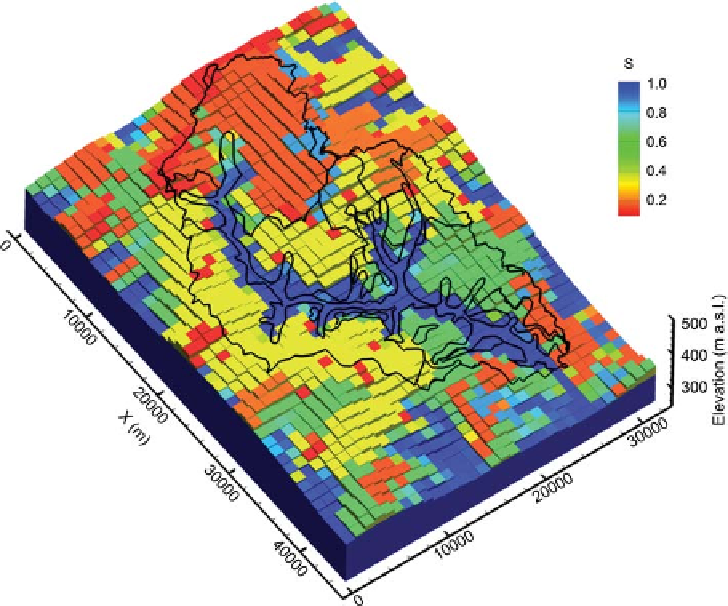Geography Reference
In-Depth Information
Figure 10.17. Relative soil
saturation (S) simulated for the Little
Washita catchment, Oklahoma, for
mid June 1999; 600 km² catchment
area. From Kollet and Maxwell
(
2008
).
Index-based models
Index-based rainfall
the approximations made a priori, they explore a selected
set of dynamics that assists in model structure choice, but
prevents them from being applied universally. Other
examples include the VIC model (Liang et al.,
1994
),
which assumes that the local soil storage capacity is dis-
tributed in space across the catchment according to the
Xinanjiang distribution, the ECOMAG model (Motovilov
et al.,
1999a
,
b
) and the YHyM model (Takeuchi et al.,
1999
,
2008
; Bastola et al.,
2008
; see
Section 11.19
).
runoff models are based on simplified
representations of hydrological processes within a catch-
ment, often with the topography as the most important
control (
Section 4.4.2
). The models make explicit assump-
tion
s about the catchment architecture and the dominant
processes, and then focus on an explicit treatment of this
identified dominant process along an assumed dominant
flow path. An example of this type of model is TOP-
MODEL (Beven and Kirkby,
1979
) based on the
topographic wetness index, which assumes that all parts
of the landscape with the same ratio of recharge and
drainage behave hydrologically similarly. TOPMODEL
was originally developed in the UK, as a way to capture
the topographic controls on the generation of saturation
excess runoff, and in this sense is applicable to catchments
where saturation excess runoff is dominant. There are two
similarity concepts invoked. The first is the assumption
that all locations within a catchment behave hydrologically
similarly if the wetness index is the same. The second is
the similarity of the dominant runoff processes, in this case
saturation excess runoff, which is usually decided upon by
a-priori perception of processes, in some instances by field
data and reading the landscape. The same model structure
can be applied to all those catchments where the under-
lying assumption of saturation excess runoff being the
dominant mechanism is fulfilled. In other words, due to
-
Conceptual models
Conceptual models make some assumptions about the
main flow processes at the catchment scale. Typically they
consist of a number of storage elements that are connected
by fluxes. Both lumped and spatially distributed models
are in use. Because the conceptual models are not based on
governing equations for mass, momentum and energy bal-
ances (apart from mass balance), different model structures
have been adopted in different parts of the world (e.g.,
Kokkonen et al.,
2003
; Littlewood et al.,
2003
; Littlewood
and Croke,
2008
; Post,
2009
). The advantage of these
models is that they are easy to construct, quick to imple-
ment with the minimum of information, and are computa-
tionally very efficient. However, care must be taken to
represent the runoff processes in a realistic manner. To
assist in choosing a suitable structure for a conceptual
model in an ungauged basin, two kinds of similarities can

Search WWH ::

Custom Search